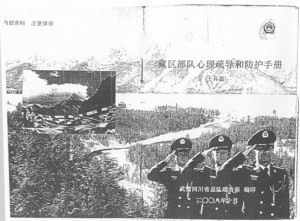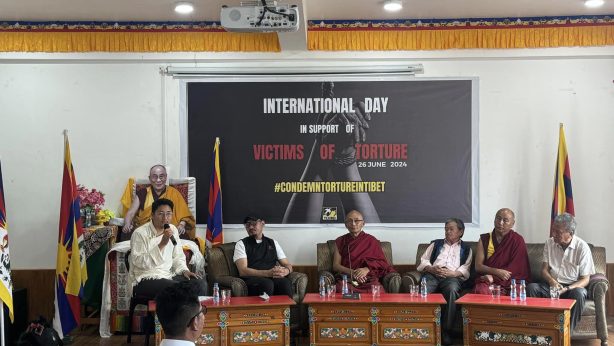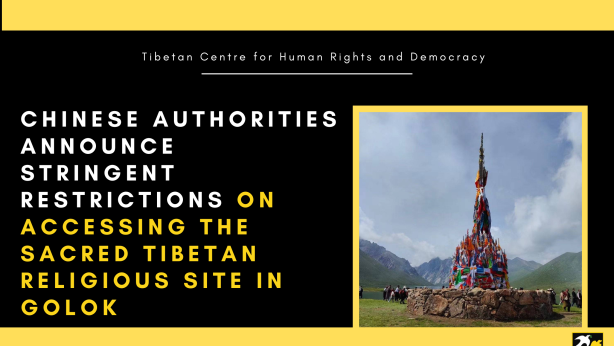‘Weakness of the Oppressor’ : Leaked document exposes psychological traumas faced by Chinese armed police in Tibet

TCHRD has received a Chinese language copy of a manual published by the Sichuan Provincial Political Department of the People’s Armed Police Force (PAPF, also called PAP), titled “Guide on Psychiatric Wellbeing While Maintaining Stability” that was circulated among different contingents, detachments and squadrons located at the province, prefecture, and county levels of Sichuan. The manual contains issues raised during a videoconference meeting held by Sichuan Province People’s Armed Police Force regarding the psychological and moral issues arising from stability maintenance work in Tibetan areas. Although the manual was drafted before Xi Jinping’s appointment earlier this year, there is no sign that he will change any of his predecessor’s policies regarding Tibet.
Experts in psychiatric health departments of armed police hospitals and other relevant organs jointly drafted the 29 questions and answers on how to cope with the violent nature of the PAPF’s work in the Tibetan areas of Sichuan Province. The 29 questions and answers focus “on providing guidance to some PAP officers on effectively deal with the common psychological traumas” caused by the horrors of their job in Tibet, and to “further improve the quality of capability of stability-maintenance work in Tibetan areas, particularly the PAP officers and other armed forces who need thorough educational and ideological guidance on their work.”
Edited and approved by Fu Wan Xuan, the director of the Sichuan Political Department of PAP and his deputy, Chen li Xue, the manual was drafted by Wang Jun Xiang, Cheng Jian Wei, Xie Lei, Wang Bin , and Zhang Wen Chun, all mental health experts working in military and armed hospitals.
In a broader sense, the manual starkly exposes the falsity of the Chinese government’s claim that Chinese rule has ‘liberated’ and brought happiness to Tibet. Repression and violence not only take a toll on the lives of the repressed but also those who perpetrate it. The casualties of China’s “life and death struggle” in Tibet, as exposed by this manual, are the victims and perpetrators alike. Those assigned with stability maintenance work in Tibet struggle with psychological problems as their most fundamental beliefs in right and wrong are twisted, violated and made irrelevant. Scientific studies have pointed out that these psychological symptoms are not limited only to first time officers but also the veterans. In this manual, China speaks mainly of some first time officers who are psychologically traumatized by their experience of implementing repressive policies sanctioned and supported by the Chinese central government in Beijing.
The manual provides guidance on maintaining the psychological health of PAP forces in Tibetan areas while simultaneously providing instructions for the same PAP forces on how to effectively maintain stability, utilizing the tactics that cause the psychological problems, such as police violence against protestors. Some PAP officers, unable to cope with changed conditions in Tibet, leave or become afflicted with psychological illnesses. The 25-page manual offers advices on the difficulties and doubts harbored by armed police officers in Tibet.
Point 11 in the manual talks about the psychiatric issues faced by some PAP officers who find it impossible to block from their minds images of an armed crackdown. The manual mentioned the “3/16” incident in Ngaba when Phuntsok, a Tibetan monk, became the second Tibetan to self-immolate and the “3/18 incident of beating, smashing, burning and looting” in Serta (Ch: Seda) and Kardze (Ch: Ganzi) counties. In both these cases, PAP forces flagrantly abused their power and fired indiscriminately into huge crowds of peaceful protesters in Tibet. The level of repression in these areas has only increased since then as Tibetan areas in Sichuan Province remain under rigorous surveillance and blocked to outsiders. Not surprisingly, the manual states that PAP officers who had participated in the “3/16” and “3/18” incidents as well as the violent crackdowns may suffer from nightmares or insomnia as they are reminded of their involvement in such incidents. The small saving grace of the ongoing tragedy in Tibet in this context is that there are some armed Chinese officers whose conscience are pricked and morally outraged by the inhumane consequences of their actions.
On the psychological crises suffered by some armed officers when faced with defiant Tibetan protesters, point 16 says:
Some comrades when they see troublemakers challenging them with Tibetan swords and stones lose their composure and become confused and discouraged, while some, when they see [protesting] maroon-robed monks, become uncomfortable and confused. [Some comrades] even fear to react when faced with such situations. Such reactions diminish the strength of armed forces’ valour and resolve in punishing [the troublemakers]. This situation is taken very seriously by the armed forces and efforts are made to complete the work successfully.
In this context, it is useful to remember that since 2008, the Chinese government has unleashed the scourge of domestic Chinese nationalism to justify its violent rule in Tibet and thus widening the ethnic hostility between Tibetans and Chinese. Official Chinese media has labeled Tibetans as ungrateful, uncivilized and wild people. Point 16 is an example of the Chinese attempts to instill enmity in the PAP so they will not hesitate to attack Tibetan protestors. This is in stark contrast to the Chinese singing paeans to ethnic unity.
Rather than speaking of ethnic unity, the manual reinforces the myth of wild, fearful Tibetan barbarians in the eyes of the Chinese saying:
No matter how [physically] strong or intimidating the Tibetan separatists may look, we [the armed forces] fulfill the needs of the masses. Under the leadership and support of the Chinese Communist Party, Central Military Commission, and president Hu Jintao, as well as support from the masses, we can fight the battle of maintaining long-term stability in Tibet.
It should be noted that the increased security build-up and repressive measures in Tibet are implemented with active support from the central government authorities including the Chinese president.
The manual describes the conflicts faced by some PAP officers about the choice of their career after experiencing the “dangerous and complex” work of stability maintenance in Tibet. It says:
The duty of maintaining stability in Tibet is tough, ridden with dangers, full of conflicts, [daily struggle] between death and life in the hailstorm of swords and guns
In the section dealing with the issue of emotional breakdowns and other psychological symptoms suffered by some first-time Chinese officers in Tibet, the manual says:
Many armed officers and soldiers posted for the first time in Tibet to work in stability maintenance become indisposed with psychological problems, including difficulty managing tempers and becoming scared to the point of losing confidence. Particularly during tense standoffs and unexpected incidents, a handful of officers become frozen with fear and paranoia unable to respond in timely fashion.
It further adds:
By clearly recognizing the political strategy [and context] of the stability maintenance work in Tibetan areas, we must ensure the victory of Chinese government and the Chinese state by following the ‘three principles’, the ‘three principles of caution’, and the ‘six mindsets required during PAP actions’.
However, this rallying call cannot hide the consequences of China’s Tibetan policy, which has not only damaged Tibetans but also caused a moral crisis among the very people China relies on to execute their inhumane strategy.
Notes:
1. ‘Weakness of the Oppressor’ From Jean-Paul Satre’s preface to Franz Fanon’s The Wretched of the Earth
2. The People’s Armed Police Force, China Daily (US Edition), 2009 http://www.chinadaily.com.cn/60th/2009-08/26/content_8619526.htm; From Chinese White Paper http://www.china.org.cn/english/features/book/194480.htm
3. For a scanned copy of the manual in Chinese language, please contact tnyinjey@gmail.com


